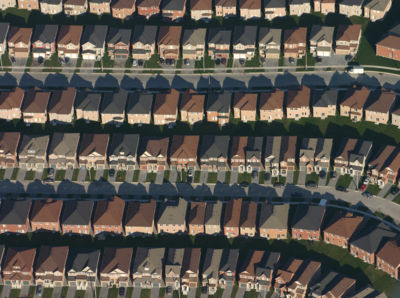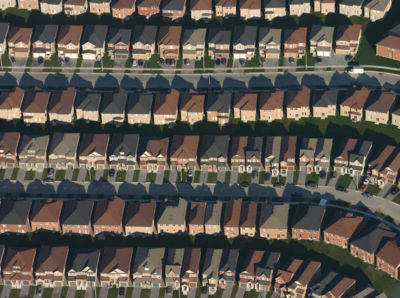Many see this
and worry about this
I see this
and worry about this
Don’t get me wrong. I worry about this
But this
will be just fine.
This
I’m not so sure.
Those of you who read this blog regularly know how I feel about urban sprawl and the separation of land uses. Urban sprawl, amongst other things, is single-handedly responsible for the destruction of communities and innovative economies, increased obesity and the death of the American city.
When American soldiers returned home from World War II in 1946 they came home to highways, automobiles, backyards and garages.
The suburbs were born.
White flight would soon follow.
The hustle and bustle of central retail districts and a thriving downtown? Over. Thank modern planners, a poor residential base left all alone, rising crime, the riots of the 1960s and the advent of the regional mall for that.
It’s been a little over sixty years since America’s introduction to urban sprawl. Local suburbs are only now starting to experience the social consequences associated with poor neighborhood planning. During the recent housing boom, hundreds of suburban neighborhoods containing thousands of cookie-cutter homes were developed in places segregated from work, shopping, transportation and entertainment at a time when housing consumer preferences show a trend of reverse white flight.
Americans are ditching the suburbs in favor of the urban experience. Empty-nesters are showing a strong preference for urban living. Furthermore, demographers estimate that by 2025, the U.S. will contain about as many single-person households as families with children. Can you guess where most single-person households want to live?
Just last week I showed a house I have listed for sale to a young prospective buyer looking to occupy the home. When I asked why she was in the market for a new home, she responded:
“I bought a brand new house 2 years ago in the vicinity of 20x St and 10x Ave down south. It’s a beautiful home, but I’m so tired of dealing with the Section 8 tenants that have moved into the neighborhood.”
Adrian Salgado: “Section 8 tenants in a 2-year old community?!”
Prospective Buyer: “It’s horrible. Everyone who bought is getting foreclosed on, houses sit vacant and most of the ones that are occupied are occupied by Section 8 tenants.”
Adrian Salgado: “That’s atrocious!”
Living in the suburbs serves its purpose when you’re one of the few living out there. However, it becomes less attractive when the suburbs become densely built and getting to and from work wipes out 3 hours of your day. It becomes less attractive when gasoline prices hover at over $3/gallon. It becomes less attractive when the Sunday mechanic you moved away from 20 years ago moves in next door. Suburban pioneers in Kendall and Pembroke Pines can attest.
Population density has the opposite effect in urban areas. The more an urban area is filled in and built up, the more crowded sidewalks start to feel safe and alive. The more people feel safe and alive, the more people move into urban areas. The more people move into urban areas, the more people available to support shops, restaurants, retail destinations, art galleries, etc, etc, etc.
So what’s going to happen to
No one knows for sure. However, if the experiences of other cities that have already experienced reverse white flight serve as precedent, there is nothing good in store for
Most of the homes in these types of communities will sell at rock-bottom prices to displaced lower-income families. Single-family residences will then be broken into multi-family living arrangements in order to make ends meet. It’s happening already. So, what do you think will happen to schools? Safety? Poverty? Quality of life? Social dysfunction?
Sound familiar? The same issues urban areas have dealt with as a result of white flight beginning in the 60s are the very same issues new age suburbs will have to deal with from here on out.
The big difference is this: many of the structures left behind in the 1960s that were eventually turned into multi-family apartments were sturdily built and as a result have been able to withstand the abuse that was handed to them. If you drive through certain parts of Little Havana, Shenandoah, Wynwood, Buena Vista, Spring Garden, etc. you can see what young urban professionals are doing to these architectural gems. Furthermore, when neighborhoods were developed in the local housing boom of the 1920s, they weren’t developed with the automobile in mind. They were developed with people in mind (what a concept). Therefore, the infrastructure, walkable street grids, mixed uses and self-sustainability have always been in place. We have something to play with. It only needs to be tweaked and improved.
The same can’t be said of properties built in the 80s, 90s and today. The structural integrity of most of those structures are questionable at best. The abuse will be handed. However, drywall and cheap framing just doesn’t hold up as well as concrete block. Infrastructure in the suburbs? It wasn’t created to support the dense development that urbanization would require. Upgrading it so that it does is almost impossible. The results will be devastating.
The next time you’re sitting in front of the tube and the media talks to you about this
scream right back: “Yo, how about this? What are we going to do about this?”
I have an idea. How about condemnation and reforestation? Let’s give some back to the wildlife in the Everglades. Maybe keep some for our personal use and become mother nature’s son. How do you think that would sit with local politicians?
Relax, suburbanites. It’s only wishful thinking on my part. Once the suburban landscape is built, it is impossible to unbuild.
However, we already witnessed the perils of white flight in urban areas. Should we just sit around and let the same thing happen to our suburbs?
Adrian Salgado is a Realtor Associate with RED I Realty in Miami, FL and can be reached at 305-491-7179 or SalgadoA@gmail.com.






